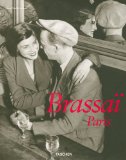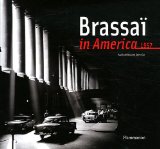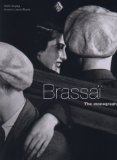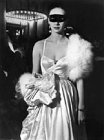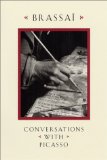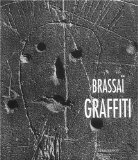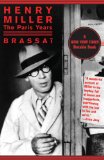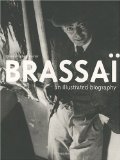Brassai:
Paris by Night
by Brassai
Hardcover from Flammarion
Published: 2012-03-27
ISBN: 2080200992
Availability: Not yet published
Arriving in Paris in 1924, Brassaï rapidly became a shrewd observer
of nocturnal Parisian life. He sensed that photography was the tool that
would allow him to document his vision of a dying society.
Fascinated by the night, which he found disconcerting, enigmatic, and
suggestive, Brassaï photographed its every aspect, from police to
prostitutes to the homeless to socialites, all in a dreamlike and mysterious
manner. In sixty-four images, Brassaï succeeded in remarkably capturing
this unique ambience. This book, meticulously assembled by Brassaï
himself, signifies the birth of the artist.
Brassaï, originally from Hungary, traveled to Paris in 1924, where
he began to associate with the avant-garde artist community, in particular
with Picasso and the Parisian surrealist circles. He quickly established
himself as one of the most original photographers of his generation. |
| |
The
Secret Paris of the '30s
by Brassai
Paperback from Thames & Hudson
ISBN: 0500271089
Availability: Usually ships in 24 hours
One of the most evocative photographic memoirs every published. It
was known that Brassai had taken a series of 'secret photographs' which
could not be published because of their daring nature - the forbidden Paris,
a sordid bas-monde where high society mingled with the underworld. |
| |
Brassai
in America
by Brassai
Hardcover from Flammarion
Published: 2011-10-11
ISBN: 2080200844
Availability: Usually ships in 24 hours
A rare discovery of more than 150 previously unpublished photographs
in black and white and in color, from a legendary photographer. Despite
strong personal and professional ties in the U.S.--Henry Miller, Harper's
Bazaar's Carmel Snow, and Edward Steichen, who featured Brassai's work
in many MoMA exhibitions--Brassai remained reticent about travel to the
U.S. until 1957 when Holiday magazine offered generous compensation
(and artistic freedom) to photograph New York and Louisiana.
From the first symbolic image of this voyage--the Statue of Liberty
appearing over the ship's prow--Brassai came under the spell of America
and his photographs innately captured his new perspective. In New York,
he was captivated by the graphic skyscrapers and the rhythmic to-ing and
fro-ing of the crowds. Unlike his static photographs of Paris--posing prostitutes,
embracing lovers, sleeping street people--here he captured sequences of
movement--children playing, fashionable women parading by, or the effects
of light filtering through the urban architecture.
In Louisiana, he continued to photograph more languorous sequences,
but here he reveled in color--the copper skin of sunbathers, the pastel
tones of prom dresses, the vibrant neon of amusement park attractions.
The New Orleans music halls, nightlife, women, and exotic vegetation recall
scenes from 1930s Paris.
This exuberant study of 1950s America offers the reader unprecedented
access to Brassai's work, including previously unpublished color photography. |
| |
Brassai:
The Monograph
by Brassai, Annick Lionel-Marie, Alain Sayag, Jean-Jacques Aillagon,
Centre Georges Pompidou, Roger Grenier
Hardcover from Bulfinch
This substantial and definitive book includes an interview with Brassais
widow and essays on his long career. This title includes superb duotone
and four-colour reproductions of Brassais work, and about 100 previously
unpublished images from famous photostories.
"The meaning of art is not authenticity but the expression of authenticity,"
wrote the Hungarian-born photographer Gyula Halász, better known
as Brassaï, whose unflinching yet deeply sensual portraits of the
seamier side of Paris nightlife during the 1930s and 1940s summon up an
era when decadence and desperation ran side by side. Brassaï's curiosity
about his subjects and the originality of his approach highlight the depth
of his identification with Paris, his adopted city. The son of a professor
of French literature, Brassaï had first visited the city at the age
of 5; later, in the early 1920s, he returned to make it his home after
completion of studies in fine art in Budapest and Berlin. Settling in the
bohemian arrondissement of Montparnasse, mixing with artists and writers,
Brassaï took up photography "in order to capture the beauty of streets
and gardens in the rain and fog, and to capture Paris by night." He lures
us into the smoky, highly charged world of clubs and cafés, where
nicotine-stained lovers in cheap clothes become impossibly desirable through
the camera's lens. Streets, stairways, and canals are moodily lit; even
a man rummaging for food in a rubbish bin takes on a cinematic aura. Yet
Brassaï's photographs contain a strange mixture of seediness and resilience
that ultimately triumphs over any false notions of glamour. He depicts
scenes of poverty and its trappings--alcoholism, prostitution, violence,
hunger. The chaotic social whirl of 1930s Paris dies down to the quiet
suffering of a city under occupation, with its two great literary lights,
Jean-Paul Sartre and Simone de Beauvoir, sitting out the war, stony-faced
in the Café de Flore. Accompanied by extracts from Brassaï's
own writings, contemporaries such as Henry Miller, and essays from other
contributors, and containing 308 images, Brassaï is a fine
testament to an artist whose images of one city have proved so enduring.
--Catherine Taylor, Amazon.co.uk |
| |
Brassai:
The Eye of Paris
by Anne W. Tucker
Hardcover from Harry N. Abrams
ISBN: 0810963809
Brassaï: The Eye of Paris is both the catalog of an exhibition
of Brassaï's photographs organized by the Houston Fine Arts Museum
and a valuable biography of the artist. In 1932, only three years after
he purchased his first camera (a Leica), Brassaï published a portfolio
of 64 photos titled Paris by Night that caused an immediate sensation.
His lively eye (seen in an enigmatic photograph at the beginning of the
book) captured fresh, unique images of the city and its citizens. Fascinated
by the underworld, he moved easily among gangsters and prostitutes in bars
and bordellos; he was equally at home among the fashionable and wealthy,
and just as devastating in his depiction of them. He used magnesium flares
for low-contrast shadows, catching his subjects in natural poses at significant
moments. The wide range of Brassaï's work is suggested by his formal
nudes, which have an affinity with Edward Weston's, and his informal portraits,
which remind viewers of Diane Arbus, who admired his work. Brassaï
was a central figure in the intellectual and artistic circles of Montparnasse
that made Paris the most exciting city in the world during the 1930s. In
a long essay that includes lively anecdotes of the photographer's relationships
with Picasso, Henry Miller, Kertesz, and many other luminaries, the author
re-creates the aesthetic and philosophical ferment of the period. Brassaï:
The Eye of Paris recognizes the artist's talents in five different
media--photography, filmmaking, sculpture, writing, and drawing--but focuses
on what he is best known for: lyrical and penetrating photographs of the
City of Light. --John Stevenson |
| |
Conversations
with Picasso
by Brassai
Paperback from University Of Chicago Press
ISBN: 0226071499
Availability: Usually ships in 24 hours"Read this book if you want
to understand me."--Pablo Picasso
Conversations with Picasso offers a remarkable vision of both
Picasso and the entire artistic and intellectual milieu of wartime Paris,
a vision provided by the gifted photographer and prolific author who spent
the early portion of the 1940s photographing Picasso's work. Brassaï
carefully and affectionately records each of his meetings and appointments
with the great artist, building along the way a work of remarkable depth,
intimate perspective, and great importance to anyone who truly wishes to
understand Picasso and his world.Henry Miller called Brassaï (born
Gyula Halasz) "The Eye of Paris." As a photographer, journalist, and author
of photographic monographs and literary criticism, he had an uncanny ability
to capture the Paris art world of the mid-20th century. Conversations
with Picasso, originally published in 1964, is a collection of Brassaï's
memoirs, resurrected from scraps of paper he stored in a huge vase each
night after his talks with the famous Spanish painter, whose work he photographed
from 1932 to 1962. In keeping with the lively bohemian spirit that so characterized
Pablo Picasso's milieu, Brassaï wrote these notes in a vivid, conversational
style, and they are now vignettes, of a sort, from a theatrical time capsule.
Presented alongside the actual photographs he took during his visits with
Picasso, Brassaï's anecdotes of the artist and his most intimate associates
paint an unforgettable portrait of Picasso the master artist and the man.
Sly humor and telling details embellish these accounts--in one particularly
well-rendered scene, Picasso throws a temper tantrum over a lost flashlight--that
vividly depict many of the artist's creative revelations, his insatiable
curiosity, and his views on the art of his time, including that of the
surrealists. One very strong image depicts Picasso, with brush in hand,
using a palette made of newspaper. Confiscated by military censors due
to the mere presence of World War II headlines, this photo represents one
of the many wartime frustrations Picasso endured, including using a bathroom
for a studio and secretly casting sculptures in scarce bronze at night.
Underneath the worshipful posturing so prevalent in writings of the time,
in which an everyday shopping list of paint colors is hailed as a prose
poem, Brassaï offers an intimate chronicle full of loving detail of
the impossible yet delightful enfant terrible. Entertaining, charming,
light but truly satisfying fare. --A.C. Smith |
| |
Brassaï
Graffiti
by Brassai
Hardcover from Flammarion
Published: 2002-05-03
ISBN: 2080107135
Brassaï became interested in the marginal art form of graffiti
in the 1930s, seeing it as a form of outsider art that could open the door
to new forms of artistic expression. His atmospheric photographs capture
the essence of this unfettered creation. Stark contrasts of black and white
alternate with softer shades of grey that meld into one another, smoothing
the harsh gouges typical of graffiti. Several of these photographs first
appeared in the Surrealist review Minotaure; others were first published
in France and Germany in 1960, in a work entitled Graffiti, which accompanied
an exhibition that visited New York, London, Milan, Baden-Baden, Frankfurt,
Hannover, and Paris. The approach was hugely influential, both for the
Surrealists and in the domain of Outsider Art. Accompanying the photographs
are selections from previously unpublished writings, including extracts
from Brassaï's own notebooks, in which he noted the presence of elements
of graffiti on the walls of Paris that he intended to photograph. The book
also contains an interview with Picasso on the subject of graffiti as an
art form. This first English language version of this classic title is
a beautifully produced edition of what is undoubtedly a seminal work in
the history of modern photography. |
| |
Henry
Miller: The Paris Years
by Brassaï
Paperback from Arcade Publishing
ISBN: 1611450284
Availability: Usually ships in 24 hours
"Wonderfully evocative. . . . leaves one pleasantly hungry."--The
New York Times
His years in Paris were the making of Henry Miller. He arrived with
no money, no fixed address, and no prospects. He left as the renowned if
not notorious author of Tropic of Cancer and Tropic of Capricorn.
Miller didn't just live in Paris--he devoured it. It was a world he shared
with Brassaï, whose work, first collected in Paris by Night,
established him as one of the greatest photographers of the twentieth century
and the most exquisite and perceptive chronicler of Parisian vice.
In Miller, Brassaï found his most compelling subject. Henry
Miller: The Paris Years is an intimate account of a writer's self-discovery,
seen through the unblinking eye of a master photographer. Brassaï
delves into Miller's relationships with Anaïs Nin and Lawrence Durrell,
as well as his hopelessly tangled though wildly inspiring marriage to June.
He uncovers a side of the man scarcely known to the public, and through
this careful portrait recreates a bright and swift-moving era. Most of
all, Brassaï evokes their shared passion for the street life of the
City of Light, captured in a dazzling moment of illumination. 16 black-and-white
photographs |
| |
Brassai:
An Illustrated Biography
by Diane Elisabeth Poirier
Paperback from Flammarion
Published: 2006-05-02
ISBN: 2080304976
Brassaé, born in Hungary as Gyula Halasz in 1894, began his artistic
apprenticeship in Berlin before moving to Paris and launching a career
that would establish him as a key figure in the evolution of photography.
Brassaé's importance as a photo-grapher was recognized early in
his career, affording him a privileged position from which to witness the
varied aspects and milieus of Parisian life during the 1920s and 1930s.
During and just after the war, Brassaé collaborated with other artists
and writers, and displayed his own artistic proficiency in multiple domains
including theater, cinema, sculpture, drawing, and writing. The late 1940s
marked the beginning of a new period in Brassaé's life, during which
he married and became a naturalized French citizen. In the 1950s and early
1960s, he traveled extensively and executed his original graffiti compositions
that would acquire international fame. Toward the end of his life, the
artist returned to reading and writing.Brassaé, who remained at
the cutting edge of avant-garde, refused to espouse a single style; his
rich body of work exceeds definition. This illustrated biography is based
largely on unpublished documents and photographs from the artist's personal
archives. The author shares stories told to her by Brassaé's wife
Gilberte and by several of the artist's friends, including Henry Miller,
Miré, Henri Michaux, and Raymond Queneau. Filtering a rich variety
of sources, Brassaé offers a detailed and multifaceted view of the
artist's life and of the bonds that link him and his legendary images to
Paris. |
| |
Brassai:
The Eye of Paris
by Anne Wilkes Tucker, Peter C. Marzio
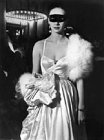 |
Brassai: The Eye of Paris is both the catalog of an exhibition
of Brassai's photographs organized by the Houston Fine Arts Museum and
a valuable biography of the artist. In 1932, only three years after he
purchased his first camera (a Leica), Brassai published a portfolio of
64 photos titled Paris by Night that caused an immediate sensation. His
lively eye (seen in an enigmatic photograph at the beginning of the book)
captured fresh, unique images of the city and its citizens. Fascinated
by the underworld, he moved easily among gangsters and prostitutes in bars
and bordellos; he was equally at home among the fashionable and wealthy,
and just as devastating in his depiction of them. He used magnesium flares
for low-contrast shadows, catching his subjects in natural poses at significant
moments. The wide range of Brassai's work is suggested by his formal nudes,
which have an affinity with Edward Weston's, and his informal portraits,
which remind viewers of Diane Arbus, who admired his work. Brassai was
a central figure in the intellectual and artistic circles of Montparnasse
that made Paris the most exciting city in the world during the 1930s. In
a long essay that includes lively anecdotes of the photographer's relationships
with Picasso, Henry Miller, Kertesz, and many other luminaries, the author
re-creates the aesthetic and philosophical ferment of the period. Brassai:
The Eye of Paris recognizes the artist's talents in five different media--photography,
filmmaking, sculpture, writing, and drawing--but focuses on what he is
best known for: lyrical and penetrating photographs of the City of Light.
--John Stevenson - Amazon.com
Hardcover - 367 pages
ISBN: 0810963809
Proust
in the Power of Photography
by Brassai, Richard Howard (Translator)
(Hardcover)
Brassai
: The Monograph
by Brassai, et al
(Hardcover)
Brassai
: Paris By Night
by Paul Morand
(Hardcover)
Conversations
With Picasso
by Brassai, et al
(Hardcover)
The
Secret Paris of the '30s
by Brassai, Richard Miller (Translator)
(Paperback)
Henry
Miller : The Paris Years
by Brassai, Timothy Bent (Translator)
Hardcover:
Arcade Publishing; ISBN: 1559702877;
Brassai
: Letters to My Parents
by Brassai, et al
(Hardcover)
Graffitti
by Brassai
(Hardcover)
Brassai
: Images of Culture and the Surrealist Observer (Modernist Studies)
by Marja Warehime
(Paperback)
Brassai
: Letters to My Parents
by Brassai, et al
(Paperback)
Henry
Miller, Happy Rock
by Brassai
(Hardcover)
The Artists of My Life
by Brassai
(Hardcover - September 1982)
Out of Print - Try Used
Books



